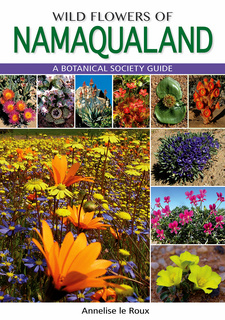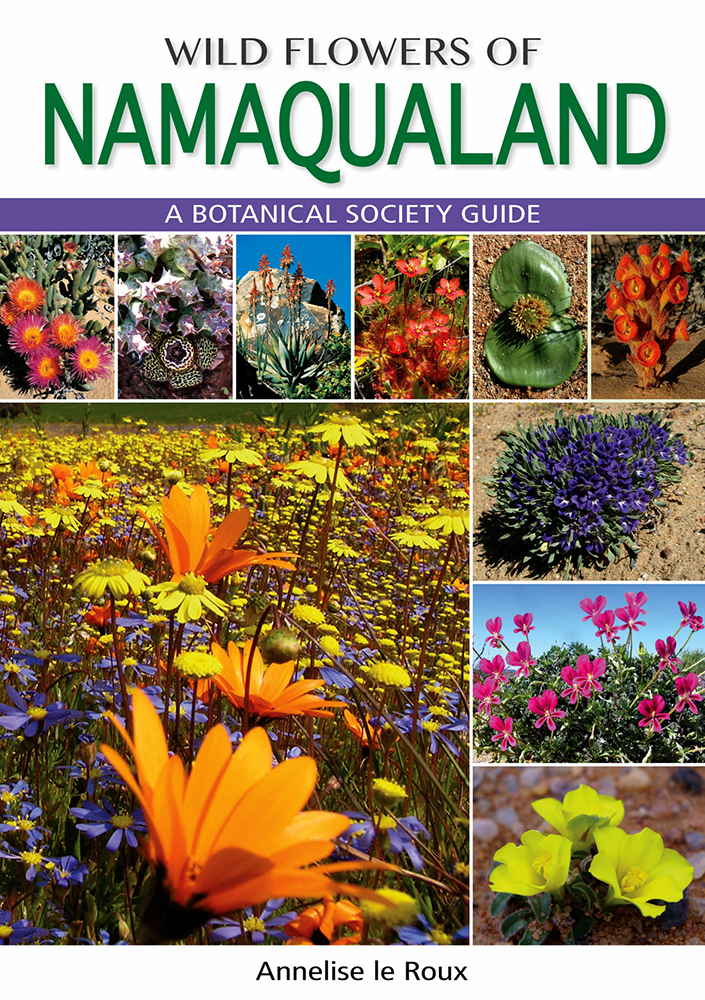Wild flowers of Namaqualand, by Annelise le Roux

Wild flowers of Namaqualand, by Annelise le Roux. Penguin Random House South Africa (Struik Nature). 4th revised edition. Cape Town, South Africa 2015. ISBN 9781775841319 / ISBN 978-1-77584-131-9
"The thought of spring in Namaqualand generally brings to mind carpets of bright orange, yellow and white flowers. During spring, Namaqualand is a wonderland, unbelievably beautiful in a good year. One stares in amazement, convinced that nothing can be more beautiful, but then a step or so further on, one stops again in awe.", writes Annelise le Roux, author of the floral guide Wild flowers of Namaqualand.
This wonder is twofold: that such masses of flowers occur and that each species seems more striking than the next. The flora of Namaqualand is unique. In this region one finds not only carpets of annuals after a good wet winter, but also a wide variety of geophytes, dwarf shrubs and succulents. Geophytes are plants with bulbs, corms or tubers, such as members of the families Hyacinthaceae, pp.119-140, and Iridaceae, pp.42-83. Succulents can vary from a creeping plant like the rank-t'nouroe (Cephalophyllum rigidum, p.308) to a large stem-succulent like the botterboom (Tylecodon paniculatus, p.156) or a tree-succulent like the quiver tree (Aloidendron dichotomum, p.98). This rich heritage of about 3,800 species, of which 28% is endemic, is certainly worth conserving for future generations. The best flower displays usually occur from early August to mid-September. Weather patterns, particularly hot bergwinds and the timing of the first substantial rainfall, determine both the time and duration of the flower season, and accurate predictions on when and how long a season will last, cannot be made. With this book, we introduce you to some of the plants of Namaqualand, hoping it may add to your enjoyment of nature. May this joy motivate a desire to conserve and protect this exceptional region, for example by stepping over and not on a plant and leaving litter in the car and not among the flowers.
WHAT MAKES THIS FLORA UNIQUE?
According to most definitions, this region is classified as a desert. A barren land for almost three-quarters of the year (summer, autumn and winter), Namaqualand becomes green and colourful for not more than two to three months in spring. This spring-summer transformation is almost unimaginable and only by seeing the change for oneself, can one appreciate it. Namaqualand is unique in being the only desert in the world to have such an extravagant and diverse spring flower display. Most plants throughout the world require warmth, together with water, to optimally grow, flower and produce seed, usually during spring and summer. They then survive unfavourable growth conditions (low temperatures and water scarcity) normally during the winter months. The climate of Namaqualand (low, sporadic winter rainfall and very hot, dry summers) offers the opposite of optimal growth conditions and is normally not conducive to plant growth. Plants of Namaqualand have adapted and developed many special features to survive cold, relatively moist winters and hot, dry summers. The plants grow slowly and even form flower buds in winter, but only burst into flower in the warmer spring months. They die off and become dormant quickly within two to three weeks at the beginning of summer and survive the very long hot, dry months through different strategies. [...]
WURMBEA
There are about 20 species of Wurmbea in southern Africa of which two occur in Namaqualand.
Wurmbea stricta
(formerly Onixotis triquetra) waterblom, vleiblommetjie COLCHICACEAE
A perennial herb up to 45cm high, with a corm. The 3 leaves are triangular, smooth and up to 40cm long, tapering towards the tip and with a sheathing base; the 2 upper leaves are just below the flowers and the third leaf is at the base of the plant. White to pink to pale purple flowers up to 1.5cm in diameter are borne close together on a long stalk. Found in areas with seasonal waters in the Kamiesberg and also southwards to the Cape Peninsula and eastwards to Port Elizabeth. Flowers August to September, but occasionally from May to November. [...]
This is an extract from Wild flowers of Namaqualand, by Annelise le Roux.
Title: Wild flowers of Namaqualand
Author: Annelise le Roux
Genre: Floral guide
Publisher: Penguin Random House South Africa (Struik Nature)
4th revised edition. Cape Town, South Africa 2015
ISBN 9781775841319 / ISBN 978-1-77584-131-9
Softcover, 15 x 21 cm, 480 pages, 600 colour photographs
le Roux, Annelise im Namibiana-Buchangebot
Wild Flowers of Namaqualand
Wild Flowers of Namaqualand introduces nearly most common 600 plant species of the region.

